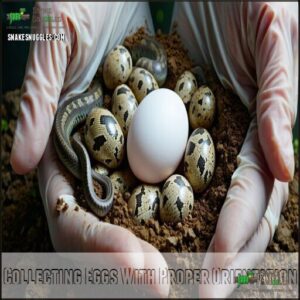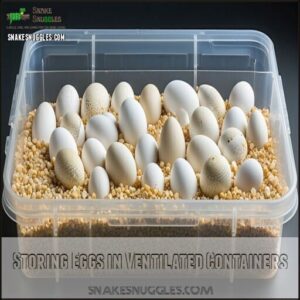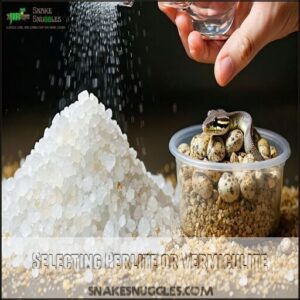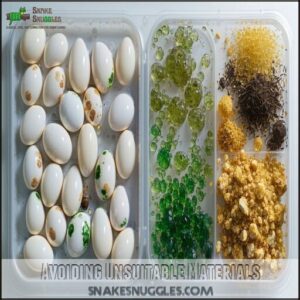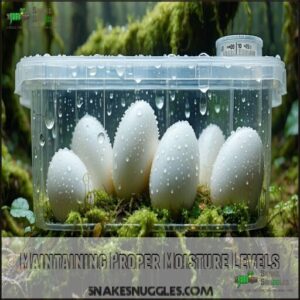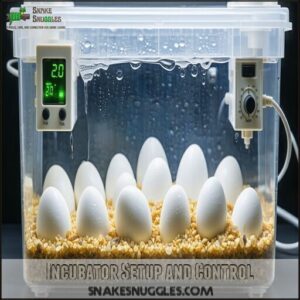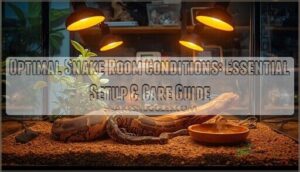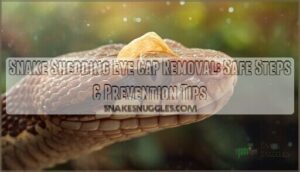This site is supported by our readers. We may earn a commission, at no cost to you, if you purchase through links.
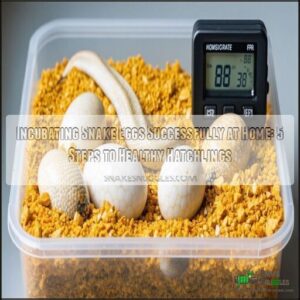
Use a stable medium like moistened vermiculite or perlite, ensuring it’s damp but not soggy (think wrung-out sponge). Handle eggs gently and keep their original orientation—marking the tops with a pencil helps.
Ventilation is essential, so don’t seal containers airtight. Check daily for mold or infertile eggs, and adjust settings as needed.
Curious about species-specific tweaks or troubleshooting? Stick around for more specialized tips on hatching healthy snakes, which requires precision and the right equipment, and is crucial for healthy snake development.
Table Of Contents
- Key Takeaways
- Pre Breeding Preparation
- Egg Collection and Handling
- Choosing Incubation Medium
- Incubator Setup and Control
- Incubation Process and Hatching
- Frequently Asked Questions (FAQs)
- Can you incubate snake eggs without an incubator?
- What temperature do snake eggs hatch?
- What temperature do milk snake eggs incubate at?
- How to identify infertile snake eggs early?
- What to do if eggs develop mold?
- Can eggs survive brief power outages in incubators?
- How to safely transport eggs during incubation?
- What to feed hatchlings immediately after birth?
- Conclusion
Key Takeaways
- Keep the incubator temperature between 80-85°F and humidity at 85-95% using tools like a good thermometer and hygrometer.
- Use moistened vermiculite or perlite as the incubation medium, ensuring it’s damp but not soggy, and handle eggs gently without rotating them.
- Ensure proper ventilation in the incubation container to prevent stagnant air and mold growth, and check daily for any issues.
- Monitor eggs regularly with candling to identify health and remove infertile ones, adjusting temperature and humidity as needed for healthy development.
Pre Breeding Preparation
You’ll need to separate your snakes and adjust their environment at least two weeks before breeding season, maintaining proper temperature (78-83°F daytime, 69-73°F nighttime), humidity (50-70%), and a consistent 10-12 hour light cycle to simulate natural breeding conditions.
Prepare your snakes early with perfect temperatures, humidity, and lighting to mimic nature and spark successful breeding behaviors.
During this vital cooling period, which typically lasts 60-90 days, you’ll also want to provide calcium-rich foods and supplements to support egg development, much like preparing a nursery before bringing home a baby.
Separating Sexes and Controlling Temperature
Separating males and females is essential for successful snake breeding.
You’ll need to stop feeding them two weeks before introduction to reduce stress. Control temperature carefully—most species require a 60-90 day cooling period with daytime temps of 78-83°F and nighttime drops to 69-73°F.
This temperature cycling benefits reproductive health and increases successful hatching rates. Precise temperature regulation prevents health complications.
Place your incubator in a stable location to maintain consistent egg temperature control, which is crucial for successful breeding and healthy hatchlings.
Maintaining Humidity and Photoperiod
Once temperature is under control, focus on humidity and photoperiod for ideal breeding conditions.
You’ll need to maintain humidity levels between 50-70% to mimic natural environments. Use a reliable hygrometer to track levels daily.
Keep your snakes on a 10-12 hour light cycle to simulate breeding season. This environmental stability triggers natural reproductive behaviors – just like setting the mood lighting for a romantic dinner, but for reptiles, which is crucial for natural environments and reproductive behaviors.
Providing Nutrition and Calcium Supplementation
Once humidity control is sorted, focus on the gravid diet.
Calcium sources like powdered supplements and gutloaded prey boost snake egg development.
Vitamin D3 aids absorption, so include it in the supplement schedule.
Offer varied prey items, ensuring they’re rich in nutrients.
Balanced nutrition reduces stress and supports healthy egg laying—think of it as prenatal care for reptiles, minus the baby showers, which is crucial for healthy egg development.
Egg Collection and Handling
When collecting snake eggs, you’ve got to handle them gently and keep their orientation intact to protect the developing embryos.
Handle snake eggs with care—keep their orientation steady to safeguard the delicate embryos and ensure successful hatching.
Using clean hands and sterile tools guarantees the eggs stay safe from contamination during transfer, which is crucial for their survival and development.
Collecting Eggs With Proper Orientation
How do you collect snake eggs without harming them? Proper egg orientation is key.
Mark the top of each egg with a soft pencil to maintain alignment. Handle gently with clean hands or sterile gloves, avoiding rotation to protect embryos.
- Mark Orientation: Use a pencil to note the top.
- Sterile Handling: Always use clean hands or gloves.
- Avoid Rotation: Keep eggs steady during collection.
Storing Eggs in Ventilated Containers
Think of your incubation container as a cozy, breathable nursery. Choose sturdy, ventilated material like plastic with small holes for airflow. Space eggs apart to prevent damage, ensuring the container size accommodates them comfortably.
Maintain humidity control by using damp vermiculite or perlite as the substrate. Proper ventilation methods keep conditions stable, essential for snake egg incubation success at home.
Insufficient airflow can lead to respiratory health risks for developing snakes.
Handling Eggs With Clean Hands and Sterile Tools
Handling snake eggs takes patience and precision. Always prioritize sanitation importance by keeping your workspace spotless.
Use clean gloves to avoid bacterial growth and mold. Sterilize tools and apply antifungal solutions sparingly.
For snake egg care:
- **Wash hands or wear gloves before handling.
- **Mark eggs gently with a pencil.
- **Never rotate eggs; keep their orientation stable.
A sterile environment guarantees healthy hatchlings!
Choosing Incubation Medium
You’ll need the right incubation medium to give your snake eggs the best chance at hatching.
Stick with materials like perlite or vermiculite, as they balance moisture and airflow perfectly while keeping harmful mold at bay, using vermiculite can be particularly effective.
Selecting Perlite or Vermiculite
When choosing an incubation medium, perlite vs vermiculite often comes down to preferences and species needs.
Vermiculite excels in moisture retention, while perlite boosts airflow.
Both require sterilization methods to prevent mold. A 50/50 mix balances humidity for snake eggs perfectly.
You can buy various perlite products online. Vermiculite’s cost is slightly higher, but its reliability makes it worth considering as a substrate for incubation.
Avoiding Unsuitable Materials
When choosing a substrate for incubation, skip materials like sand, soil, or coconut husk.
These trap too much moisture, inviting bacterial growth and killing egg health. Stick with safer options to aid mold prevention and guarantee a sterile environment.
Unsuitable materials risk substrate contamination, creating the perfect storm for problems. Eggs deserve care, not a DIY science experiment gone wrong!
Maintaining Proper Moisture Levels
Getting substrate hydration right is vital for reptile egg humidity. Aim for a 1:1 water-to-incubation medium ratio by weight.
Use a hygrometer for calibration, checking levels often to avoid mold on snake eggs. Manage condensation by misting with distilled water as needed.
For ideal egg health, remember to maintain proper humidity. Keep substrate moisture consistent—too dry, and eggs shrivel; too wet, and bacteria thrive, which affects the overall reptile egg humidity.
Incubator Setup and Control
Setting up your incubator correctly is essential for healthy snake egg development, so don’t skip the details.
You’ll need to focus on temperature, humidity, and airflow to create a stable, controlled environment that mimics natural conditions.
Choosing a Reliable Incubator Type
Selecting the right reptile egg incubator is vital.
Commercial options like Exo Terra or Zoomed offer reliable temperature stability, while a DIY incubator setup can save money.
Match incubator size to your clutch and verify it meets ventilation needs.
Many consider incubator product availability when making their selection.
- Commercial options: Feature digital controls and ease of use.
- DIY incubators: Cost-effective but require assembly.
- Temperature stability: Key for healthy embryos.
Ensuring Good Ventilation and Insulation
Good ventilation and insulation are essential for stable snake egg incubation.
Use foam insulation materials to maintain temperature stability and prevent condensation.
Strategically place vents to guarantee proper airflow without drying the eggs.
For DIY incubator setups, position your equipment in a stable location, away from drafts or direct sunlight.
Think of it as giving your eggs their own cozy, climate-controlled apartment.
| Key Aspect | Why It Matters | Suggested Material/Method | Tip |
|---|---|---|---|
| Airflow strategies | Prevents stagnant air | Strategic vent placement | Avoid blocking vents entirely |
| Insulation materials | Maintains temperature | Foam insulation | Seal gaps for better efficiency |
| Condensation prevention | Protects egg surfaces | Proper ventilation setup | Monitor for excess moisture |
| Incubator placement | Guarantees stable conditions | Away from drafts or heat | Use a thermometer to double-check |
Good ventilation and insulation are crucial for the success of the incubation process, and by following these guidelines, you can create an optimal environment for your snake eggs.
Monitoring Temperature and Humidity
Keeping your incubation environment steady is key—think of it as babysitting eggs, but with less diaper duty.
- Use digital monitoring tools to track temperature stability and humidity calibration.
- Set alarms systems for species variance; Corn Snakes love 82-85°F, Ball Pythons prefer 88-90°F.
- Check egg monitoring twice daily, adjusting temperature control or humidity control promptly to avoid surprises.
To guarantee accuracy, consider using a reliable temperature monitor.
Incubation Process and Hatching
You’ll need to keep a close eye on temperature, humidity, and egg condition to give your hatchlings the best chance at survival.
With careful monitoring and minor adjustments, you can create the perfect environment for those tiny snakes to make their grand entrance, which requires a close eye on their survival.
Researching Species Specific Requirements
Understanding species-specific requirements is key to successful snake egg incubation.
Research your snake’s natural habitat, focusing on temperature ranges, humidity needs, and incubation length.
For example:
| Species | Temperature Range (°F) | Humidity Needs (%) | Incubation Length (Days) |
|---|---|---|---|
| Ball Python | 86-92 | 90-100 | 55-65 |
| Corn Snake | 78-84 | 75-90 | 58-62 |
| King Snake | 75-82 | 50-70 | 55-75 |
Tailoring home incubation methods guarantees healthy hatchlings.
Maintaining temperature and humidity is critical throughout the incubation period to ensure the best results for successful snake egg incubation.
Maintaining Proper Humidity and Temperature
Maintaining humidity control and temperature stability is key to incubating snake eggs.
Use a hygrometer and thermometer to track levels, keeping humidity between 85-95% and temperatures steady based on species needs.
Equipment calibration helps avoid troubleshooting extremes.
Mist the substrate lightly if needed, but don’t overdo it—nobody likes soggy eggs!
A well-monitored incubator setup guarantees healthy development and is crucial for maintaining the right conditions, which is the key to successful incubation, ensuring temperature stability.
Monitoring Egg Condition and Adjusting Settings
Sneaking a quick peek at your snake eggs? It’s essential to monitor their condition without disturbing them too much.
Check for mold spots, dimpling, or shriveling, as these signal hydration or shell integrity issues. Keep conditions stable with small temperature adjustments and proper humidity control.
Try candling the eggs to spot healthy veins—it’s like a mini ultrasound, but cooler!
- Spot mold early to prevent embryo harm.
- Adjust hydration levels: eggs shouldn’t shrink or swell.
- Use the candling technique to check embryo vitality.
- Address temperature fluctuations promptly for healthy growth.
Checking for Signs of Hatching and Removing Infertile Eggs
As snake egg development progresses, watch for pipping signs—tiny cracks signaling hatchling emergence.
Use egg candling early to spot infertile snake eggs, removing them to boost hatch rates and prevent mold. Fertile eggs show veining, while infertile ones stay clear.
Avoid rotating eggs during checks. Hatching snake eggs takes patience, so let nature work its magic.
| Task | What to Look For | Action | Why It Matters |
|---|---|---|---|
| Pipping Signs | Cracks on eggshells | Leave undisturbed | Supports natural emergence |
| Egg Candling | Veins or clear yolk | Remove infertile eggs | Prevents contamination |
| Infertile Identification | Clear, no embryo signs | Discard carefully | Saves space and resources |
| Hatchling Emergence | Hatchlings breaking shells | Avoid interference | Guarantees healthy development |
Frequently Asked Questions (FAQs)
Can you incubate snake eggs without an incubator?
You can incubate snake eggs without an incubator by using a warm, stable environment like a DIY setup.
Maintain consistent temperature (78-90°F) and high humidity (85-95%) with a moist substrate, like damp vermiculite.
What temperature do snake eggs hatch?
It’s surprising how snake eggs thrive best between 78-90°F, depending on the species.
Think of it like baking cookies; too hot or too cold, and things won’t turn out quite right!
What temperature do milk snake eggs incubate at?
Keep milk snake eggs cozy at 80-85°F during incubation for healthy development.
Too warm or too cold could harm the embryos.
Stick to this sweet spot, and you’ll boost your chances of hatching success!
How to identify infertile snake eggs early?
Early signs of infertile snake eggs include misshapen or shriveled shells, an off-white or yellowish appearance, and lack of visible veins when candled.
Gently inspect eggs, but avoid rotating them to prevent damage.
What to do if eggs develop mold?
Picture tiny white domes sprinkled with unwanted fuzz—gently remove mold using a cotton swab dipped in diluted antifungal solution.
Avoid wetting the egg’s surface, adjust humidity, and isolate affected eggs to prevent contamination.
These steps are crucial for maintaining the health and integrity of the eggs.
Can eggs survive brief power outages in incubators?
Yes, eggs can usually survive short power outages if you maintain stable temperatures.
Wrap the incubator in a blanket for insulation, and avoid opening it.
A few hours of fluctuation typically won’t harm development.
How to safely transport eggs during incubation?
Ever wonder if eggs can handle a bumpy ride?
To transport safely, use damp vermiculite in ventilated containers, maintain their orientation, and avoid shaky movements.
Stable temperatures and calm handling will keep embryos thriving.
What to feed hatchlings immediately after birth?
Feed hatchlings small, live, or pre-killed prey like pinky mice, sized to match their body width.
Wait until they’ve shed their first skin, typically a week after birth, to confirm they’re ready to eat.
Conclusion
Mastering the art of incubating snake eggs successfully at home requires precision and patience, but it’s incredibly rewarding.
From preparing breeding pairs to setting up the perfect incubator, every step matters.
Remember, small tweaks like keeping humidity steady and monitoring egg condition daily can make a big difference.
Don’t rush—nature takes time. With the right tools, attention to detail, and a little persistence, you’ll give those hatchlings the best possible start.
Who knew science could be this hands-on?


